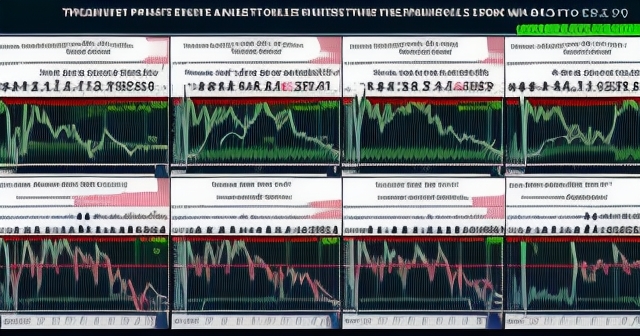Navigating the Currents: A Comprehensive Guide to Understanding Bull and Bear Stock Markets
Welcome to the dynamic world of stock markets, where prices ebb and flow like the tides. As you embark on your investment journey, or perhaps seek to deepen your understanding, you’ll frequently encounter two powerful forces shaping market movements: the bull and the bear. These aren’t just catchy animal metaphors; they represent fundamental market conditions with profound implications for your investment strategy and outcomes. Understanding the core differences between a bull market and a bear market is absolutely crucial for anyone looking to navigate the financial landscape successfully.
Think of the stock market as a vast ecosystem. Sometimes it’s thriving and full of energy – that’s the bull market. Other times, it’s facing challenges, perhaps retreating or hibernating – that’s the bear market. These states don’t just describe whether prices are going up or down; they reflect the underlying economic health, investor sentiment, and supply-demand dynamics at play. Our goal here is to peel back the layers, explore what defines each market state, examine their historical context, and discuss practical approaches for investors like you.
So, what exactly differentiates these two market states? At their most basic level, they are defined by the prevailing trend in stock prices over a sustained period. But as we will discover, the story goes much deeper than simple price movements. We will explore the forces that drive these trends, the economic conditions that often accompany them, and how investors have historically weathered these cycles.
Below is a summary of the fundamental characteristics of bull and bear markets:
- Bull markets are marked by rising stock prices and investor optimism.
- Bear markets are characterized by falling prices and investor pessimism.
- Understanding these market states can guide investment strategies.
| Market Type | Characteristics | Investor Sentiment |
|---|---|---|
| Bull Market | Rising stock prices, high demand | Optimistic |
| Bear Market | Falling stock prices, high supply | Pessimistic |
Defining the Beasts: What Constitutes a Bull vs. a Bear Market?
Let’s start with the fundamental definitions. The terms themselves come from the ways these animals attack. A bull charges forward, goring upwards with its horns. A bear swipes downward with its paws. This imagery neatly encapsulates the market direction they represent.
A bull market is characterized by a sustained period of rising stock prices. While there’s no single, universally agreed-upon metric for its beginning, it’s commonly understood as a market that has risen 20% or more from a recent low point. More importantly, a bull market is associated with optimism, high investor confidence, and expectations of further gains. It’s a period where demand for stocks generally outweighs supply, pushing prices higher across a wide range of securities.
Conversely, a bear market is characterized by a sustained period of falling stock prices. The commonly accepted definition is a market decline of 20% or more from a recent high point. Bear markets are typically accompanied by widespread pessimism, fear, and a lack of investor confidence. During a bear market, supply tends to exceed demand as investors rush to sell, driving prices down. Unlike short-term dips or “market corrections” (which are often defined as declines of 10-20%), a bear market implies a more significant and potentially prolonged downturn.
It’s vital to understand that these definitions refer to the market as a whole, typically measured by major market indices like the S&P 500, the Dow Jones Industrial Average (DJIA), or the Nasdaq composite. Even in a bull market, some individual stocks or sectors may decline, and in a bear market, some may rise. However, the terms “bull” and “bear” describe the dominant trend affecting the majority of stocks.

Beyond the Ticker: Characteristics That Signal Bull or Bear
While the 20% price change is a useful benchmark, identifying a bull or bear market involves looking at a broader set of characteristics. These traits offer deeper insights into the underlying health and sentiment driving the market.
In a bull market, you’ll typically see:
- Strong Demand, Low Supply: Investors are eager to buy stocks, leading to high demand. Those who hold stocks are reluctant to sell, keeping supply relatively low. This imbalance naturally pushes prices up.
- Positive Investor Psychology: Sentiment is overwhelmingly optimistic. There’s a feeling of confidence and opportunity. This positive outlook can become a self-fulfilling prophecy, encouraging more buying and further fueling the rally. Sometimes this can even lead to exuberance or irrational optimism.
- Robust Economic Conditions: Bull markets usually occur during periods of economic expansion. This includes strong economic growth (as measured by GDP), low or falling unemployment rates, and increasing corporate profits. Businesses are doing well, which supports higher stock valuations.
- Increased Trading Volume: As excitement and participation grow, trading volume often increases during a bull market, particularly on upward price movements.
Conversely, a bear market exhibits the opposite characteristics:
- Low Demand, High Supply: Investors are hesitant to buy, often preferring safer assets or holding cash. Many investors are actively trying to sell, leading to high supply. This imbalance drives prices down.
- Negative Investor Psychology: Sentiment is pessimistic and fearful. Investors are concerned about future losses and may panic sell. This fear can also be self-reinforcing, accelerating the market’s decline. Volatility tends to increase significantly during bear markets.
- Receding Economic Conditions: Bear markets often coincide with or precede periods of economic contraction or slowdown, potentially leading towards a recession. This involves weaker economic growth, rising unemployment rates as companies face challenges, and declining corporate profits. Businesses struggle when consumers and other businesses are not spending enough.
- Decreased Trading Volume (often): While panic selling can spike volume on down days, overall trading volume might decrease as potential buyers step to the sidelines.
| Indicator | Bull Market | Bear Market |
|---|---|---|
| Demand/Supply | High Demand, Low Supply | Low Demand, High Supply |
| Investor Sentiment | Optimistic | Pessimistic |
| Economic Conditions | Robust | Receding |
Understanding these underlying dynamics is crucial because they explain *why* prices are moving the way they are, offering a richer picture than just observing the price chart alone. Investor psychology, in particular, plays a powerful role, often amplifying trends beyond what pure fundamentals might suggest.
The Economic Pulse: How Market States Reflect and Influence the Economy
The relationship between the stock market and the broader economy is complex and often discussed. While the stock market is not the sole indicator of economic health, it is a significant one, often acting as a forward-looking barometer.
As mentioned, bull markets are strongly associated with strong economic performance. When companies are profitable, hiring, and expanding, it reflects positively on their future earnings potential, justifying higher stock valuations. Rising stock prices, in turn, can create a wealth effect – investors feel wealthier, which can encourage more spending and further stimulate the economy. It’s a virtuous cycle.
Bear markets, however, are frequently a symptom or a harbinger of economic trouble. A significant market downturn signals that investors collectively believe the future economic outlook is poor. This could be due to various factors such as:
- Struggling economic growth
- High and persistent inflation, eroding purchasing power
- Rising interest rates, making borrowing more expensive for businesses and consumers
- Decreasing consumer spending
- Falling corporate profits
- Geopolitical events or policy changes that create uncertainty
A bear market in stocks can also have a negative impact on the real economy. The reverse wealth effect can cause consumers and businesses to cut back on spending and investment. Companies may find it harder to raise capital through issuing stock. Rising unemployment often accompanies a bear market, as businesses react to slowing demand and uncertain futures by laying off workers.
It’s also important to note that while bear markets and recessions often go hand-in-hand, they are not the same thing. A recession is technically defined by economists (like the National Bureau of Economic Research in the U.S.) as a significant decline in economic activity spread across the economy, lasting more than a few months, normally visible in GDP, income, employment, industrial production, and wholesale-retail sales. A bear market is specifically about stock prices falling. A bear market can sometimes occur without a recession, and a recession can sometimes occur without a bear market, though overlap is common.

Historical Perspectives: Cycles, Duration, and Depth
Understanding the history of bull and bear markets provides valuable context for investors. Markets move in cycles, and knowing the typical patterns can help manage expectations and fear.
Historically, bull markets tend to last significantly longer than bear markets. The period from March 2009 to February 2020, following the Great Recession, was the longest bull market on record for the S&P 500, spanning nearly 11 years. Bull markets can deliver substantial returns, reinforcing the benefits of long-term investing.
Bear markets, while shorter, can be sharp and painful. Looking at historical data since World War II (specifically focusing on the S&P 500):
- The average bear market lasts approximately 13 months from its peak to its lowest point (the trough).
- The average price decline during a bear market is around 33%.
- The time it takes for the market to recover from the bear market low back to its previous peak level averages about 27 months.
| Bear Market Fact | Average Duration | Average Decline |
|---|---|---|
| Time to Low | 13 months | 33% |
| Time to Recovery | 27 months | N/A |
It’s important to remember these are averages. Some bear markets have been shorter and shallower, while others have been longer and deeper. For instance, the bear market triggered by the COVID-19 pandemic in early 2020 was one of the shortest on record, lasting only about a month, though the subsequent recovery was remarkably swift. In contrast, the bear market during the Great Depression was far longer and resulted in a much more severe decline.
Interestingly, analysis of past bear markets suggests that faster market declines into bear territory *may* sometimes indicate shallower eventual declines, though this is not a guaranteed rule. The speed and causes of the downturn matter.
Notable Bear Markets in History: Learning from the Past
Examining specific historical examples helps illustrate the concepts and variety of bear markets:
- The Great Depression (1929-1932): The most severe bear market in modern history, triggered by rampant speculation and leading to a collapse in the financial system and a prolonged economic depression. Prices fell by nearly 90%.
- The Dot-Com Bubble Burst (2000-2002): Fueled by excessive speculation in internet and technology stocks, this bear market saw the Nasdaq composite index fall dramatically, though the S&P 500 and DJIA experienced less severe declines.
- The Great Recession (2007-2009): Caused primarily by the collapse of the U.S. housing market and subsequent financial crisis, this bear market saw the S&P 500 drop by over 50%.
- The COVID-19 Crash (2020): A sudden and rapid bear market triggered by the global economic shutdown in response to the pandemic. It was notable for its speed and the equally rapid rebound that followed as governments and central banks implemented massive stimulus measures.
- The 2022 Bear Market: Triggered by factors including high inflation, rising interest rates by central banks (like the U.S. Federal Reserve) to combat inflation, supply chain issues, and geopolitical tensions (such as the Russia-Ukraine war). This market saw significant declines across major indices.

Each bear market has its unique triggers and characteristics, but they all share the common themes of declining prices, negative sentiment, and often, economic headwinds. Yet, a crucial historical lesson is that markets have eventually recovered from *every* single one of these downturns to reach new highs.
Causes and Triggers: What Can Turn a Bull into a Bear?
Understanding the potential catalysts for a shift from a bull to a bear market can help investors be aware of potential risks, although predicting market turns is notoriously difficult.
Bear markets are typically triggered by factors that threaten future corporate profits and economic stability. Common causes include:
- Economic Slowdowns or Recessions: As businesses face decreased demand and profits fall, their stock values decline.
- High Inflation: Persistent inflation erodes consumer purchasing power and increases business costs, negatively impacting earnings. Central banks respond by raising interest rates, which makes borrowing more expensive and can slow economic growth.
- Rising Interest Rates: Higher rates increase the cost of capital for companies and make bonds and other fixed-income investments relatively more attractive compared to stocks, potentially drawing money out of the equity market.
- Asset Bubbles Bursting: When speculation drives the price of an asset (like tech stocks in 2000 or housing in 2007) far beyond its intrinsic value, the eventual correction can trigger a broader market downturn.
- Geopolitical Events: Wars, political instability, or international crises can create uncertainty and fear, leading to market sell-offs.
- Policy Changes: Government policies can significantly impact markets. For example, concerns about the economic impact of the Trump administration’s tariffs in 2018-2019 contributed to market volatility. These import taxes were feared to sink the global economy and complicate business decisions, adding to inflationary pressure and provoking retaliatory tariffs, causing economic pain. Such policies can delay investments and disrupt supply chains.
Often, it’s a combination of several factors that culminates in a loss of investor confidence and a sustained downtrend. Monitoring key economic indicators and being aware of major global events is part of staying informed as an investor.
Bear Markets and Recessions: Overlap and Distinction
We’ve touched upon the relationship, but let’s clarify it further. A bear market is often seen as a predictor of a recession, but they are not perfectly correlated.
Since World War II, there have been periods where the market entered bear territory without a subsequent official recession, and vice versa. For instance, the market saw bear-like declines in 1962, 1966, and 1978, and again in 1987, that didn’t coincide with official recessions. Similarly, there have been recessions, like those in 1945, 1980, and 2001 (partially), that did not feature a classic 20%+ market decline from a peak.
However, the overlap is significant. Most major recessions have coincided with or been preceded by a bear market. The economic weakness that defines a recession – falling GDP, rising unemployment, declining industrial production – naturally impacts corporate profits and investor sentiment, which drives stock prices down into bear territory.
Economists sometimes raise recession odds when the market enters a bear phase, partly because the market’s decline itself can dampen economic activity, and partly because the factors causing the market decline (like high inflation leading to aggressive rate hikes) are often the same factors that cause recessions. So, while not identical, bear markets and recessions are often linked cycles of economic contraction and financial market decline.
Navigating the Terrain: Investing Strategies for Bull Markets
Investing in a bull market can feel exhilarating. The general trend is upwards, and many investors see the value of their portfolios grow. What are some common approaches during these periods?
In a strong bull market, the adage “the trend is your friend” often holds true. A primary strategy for many investors is to:
- Buy Early and Hold: Identifying promising investments early in a bull market and holding onto them as prices rise can yield significant returns.
- Focus on Growth Stocks: Companies with high growth potential often perform exceptionally well in a booming economy and optimistic market.
- Stay Invested: Trying to time the market by jumping in and out can lead to missing the best-performing days. Since bull markets are the longest phase, staying invested allows you to capture the bulk of the gains.
- Consider Leverage (with caution): Some experienced traders might use margin (borrowed money) to increase their potential returns, but this also significantly increases risk if the market unexpectedly turns.
Below are common strategies employed in bull markets:
| Strategy | Description |
|---|---|
| Buy Early | Identify investments at the start of the bull market. |
| Growth Stocks | Invest in stocks with high growth potential. |
| Stay Invested | Maintain positions to capture gains over the long term. |
The key in a bull market is often patience and conviction in your investments. While periodic rebalancing of your portfolio is still wise, excessive trading or trying to call the market top can detract from long-term returns.
Navigating the Storm: Investing Strategies for Bear Markets
Bear markets present different challenges and opportunities compared to bull markets. The prevailing sentiment is negative, volatility is high, and watching your portfolio value decline can be emotionally difficult. So, how can you navigate this challenging environment?
For long-term investors, a bear market is primarily a test of patience and discipline. The historical data shows that markets recover. Panicking and selling all your investments at the bottom locks in losses and prevents you from participating in the eventual recovery. Therefore, a core strategy is often to:
- Maintain a Long-Term Perspective: Remember your financial goals extend years or decades into the future. Short-term market fluctuations are less critical than the long-term growth potential.
- Avoid Emotional Decisions: Fear can be a powerful motivator to sell, but it’s often the wrong move for long-term success. Stick to your pre-defined investment plan.
- Dollar-Cost Averaging (DCA): Continue investing a fixed amount of money at regular intervals, regardless of market price. In a falling market, this means you buy more shares at lower prices, which can significantly benefit your average cost basis when the market recovers. This is a powerful strategy for managing the fear of buying at the “wrong” time.
- Diversification: Ensure your portfolio is diversified across different asset classes (stocks, bonds, potentially real estate) and different sectors or geographies. Some assets may perform better during downturns than others. Defensive stocks (like utilities or consumer staples) or certain types of bonds may hold up better than aggressive growth stocks.
- Evaluate Your Investments: A bear market provides an opportunity to review your holdings. Are the companies you own still fundamentally sound? Or has the downturn exposed weaknesses? This isn’t about panic selling, but about ensuring your portfolio aligns with your long-term strategy and risk tolerance.
- Look for Opportunities: For investors with cash on the sidelines or who continue to invest via DCA, bear markets offer the chance to buy quality assets at discounted prices. Many of the best-performing investment periods have started during or just after market bottoms.
| Strategy | Description |
|---|---|
| Long-Term Perspective | Focus on long-term goals rather than short-term declines. |
| Avoid Emotional Decisions | Stick to your investment plan despite market fear. |
| Dollar-Cost Averaging | Invest regularly to lower average cost in a declining market. |
For more experienced or active traders, bear markets can present opportunities beyond just buying dips:
- Short Selling: Profiting from falling prices by selling borrowed shares in the hope of buying them back later at a lower price. This is a high-risk strategy and complex, typically only suited for experienced traders.
- Investing in Inverse Funds or Options: Financial instruments designed to profit from market declines. Again, these involve significant risk and complexity.
Choosing the right approach in a bear market depends heavily on your financial situation, risk tolerance, and investment knowledge. For most long-term investors, disciplined investing, diversification, and avoiding emotional reactions are key.
If you are exploring different investment avenues and considering various trading instruments, including potentially engaging with strategies in fluctuating markets, the choice of platform matters. If you’re considering starting foreign exchange trading or exploring more Contracts for Difference (CFD) products, then Moneta Markets is a platform worth considering. Hailing from Australia, it offers over 1000 financial products, suitable for both novice and professional traders alike.
The Long View: Market Recovery and Historical Optimism
Perhaps the most comforting truth about stock markets, especially during a downturn, is their historical tendency to recover. While bear markets can be frightening and cause significant paper losses, the data is clear: stock markets have historically come back from every prior bear market to eventually rise to another all-time high.
This long-term perspective is what underpins the strategies of successful investors who navigate these cycles. They understand that bear markets are a natural, albeit painful, part of the market cycle. They are periods of price reset, often driven by necessary economic adjustments or corrections of prior excesses.
Below is a summary of the historical performance of stock markets after bear markets:
- Markets historically rebound after downturns.
- Investors come back to capture gains as sentiment improves.
- Avoiding market timing helps in benefiting from recovery phases.
The recovery phase, which transitions back into a new bull market, can happen quickly and unexpectedly. Historically, some of the best days for Wall Street have occurred during or immediately after bear markets, as sentiment begins to shift and buyers return. Being out of the market during these sharp upward moves can significantly impact long-term returns.
Therefore, while acknowledging the risks and challenges of a bear market, the long-term historical pattern provides a powerful argument for staying invested according to your plan, focusing on quality assets, and remembering that market downturns are temporary states in the journey of long-term wealth creation.
In choosing a trading platform to execute various investment strategies, especially if you are looking to trade diverse asset classes or utilize different trading tools across market conditions, flexibility and technological capability are important considerations. When choosing a trading platform, the flexibility and technical advantages of Moneta Markets are worth mentioning. It supports mainstream platforms such as MT4, MT5, and Pro Trader, combined with high-speed execution and low spread settings, providing a good trading experience.
Conclusion: Riding the Waves with Knowledge and Strategy
Bull and bear markets are not merely academic concepts; they are tangible forces that impact your investment portfolio. A bull market is a period of optimism, rising prices (typically 20%+ from a low), strong economic conditions, and high demand for securities. A bear market is its challenging counterpart, marked by pessimism, falling prices (typically 20%+ from a high), receding economic conditions, and low demand/high supply. Both are natural parts of the market cycle.
Understanding their definitions, the underlying economic and psychological drivers, and their historical patterns is essential for any investor. While bear markets can be difficult, characterized by volatility, fear, and potential losses, history teaches us they are temporary and have always been followed by recoveries and new periods of growth. Navigating these periods requires a blend of knowledge, discipline, and a clear strategy.
For investors, this means having a long-term plan, diversifying your portfolio, avoiding impulsive decisions driven by fear or greed, and potentially using strategies like dollar-cost averaging to turn downturns into opportunities to buy at lower prices. Focusing on the long game and the fundamental strength of your investments rather than getting caught up in short-term swings is often the most prudent course.
Whether the market is roaring like a bull or retreating like a bear, being informed and prepared allows you to approach investing with confidence, turning potential challenges into stepping stones towards achieving your financial goals.
bull and bear stock market definitionFAQ
Q:What is a bull market?
A:A bull market is a period characterized by rising stock prices, typically defined as an increase of 20% or more from a recent low.
Q:What is a bear market?
A:A bear market is a period marked by falling stock prices, usually defined as a decrease of 20% or more from a recent high.
Q:How do bull and bear markets affect investor sentiment?
A:Bull markets generally bring optimism and confidence among investors, while bear markets evoke fear and pessimism, influencing investment decisions.

留言